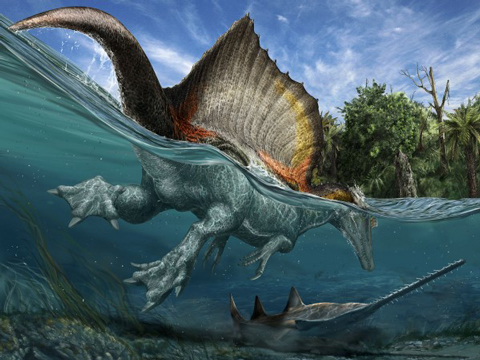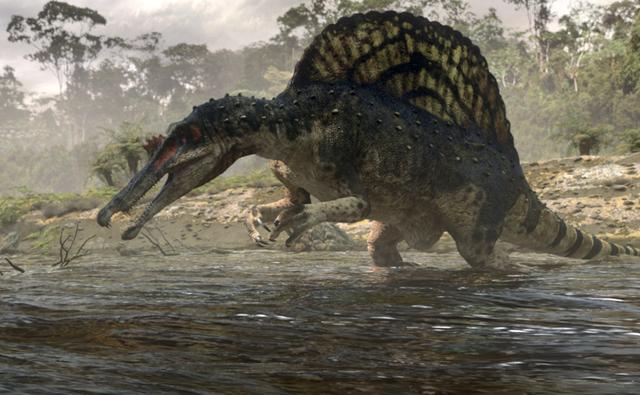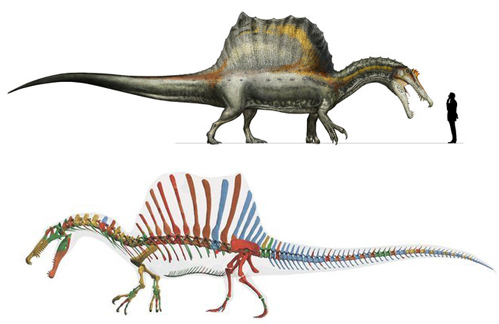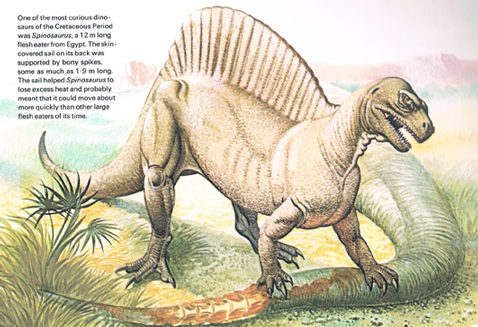Spinosaurus “Four Legs are Better than Two”?
Spinosaurus – Steps into the Spotlight (Once Again)
And so, the long awaited paper that re-evaluates the fossil data on the Spinosaurus genus and specifically S. aegyptiacus was published in the academic journal “Science” yesterday. Time to open a new chapter on this, one of the most enigmatic, mysterious and bizarre of all the known Theropoda. Since the paper’s submission in the summer, there has been a lot of debate in scientific circles with regards to what this new study will show. The paper’s title “Semi-aquatic Adaptations in a Giant Predatory Dinosaur”, is almost an understatement, when this is contrasted with the lurid headlines we have seen from a large number of media outlets.
Re-examining What We Thought We Knew About Spinosaurus
In very brief summary, the dedicated team of international researchers have re-assessed the known fossil material on Spinosaurus. They have been able to track down the location in Morocco from which a number of Spinosaurus bones were excavated and sold via a fossil dealer. The team have then re-examined this site and found further material. Their efforts has led to a considerable re-think in terms of what this animal looked like and how it moved. This new study interprets Spinosaurus as a sixteen-metre- plus dinosaur, that considered itself more at home in the water than on land. Although capable of terrestrial locomotion, unlike every other large theropod, a new rendering sees Spinosaurus as an obligate quadruped. Here is a meat-eating dinosaur that walked on all fours.
A Semi-Aquatic Obligate Quadruped – Spinosaurus
Picture credit: Davide Bonadonna, Nizar Ibrahim, Simone Maganuco
Spinosaurus
In the picture above, a web-footed Spinosaurus pursues a prehistoric swordfish, known as Onchopristis. Earlier studies and research based on other members of the Spinosauridae suggest that fish may have made up a substantial proportion of their diet. Instead of perching on the river bank, attempting to claw fish out of the water like some form of giant, prehistoric Grizzly bear, an ecological niche trumpeted by ourselves to the CGI team helping with the rendering of Spinosaurus for an episode of the BBC television series “Planet Dinosaur” back in 2011, this latest interpretation goes a lot further.
Beyond “Planet Dinosaur” – The Transformation of Spinosaurus aegyptiacus
Picture credit: BBC
Building Up a New Picture
Having re-visited what records and remaining photographs that exist of the original Stromer material excavated from the Western desert of Egypt around a 100 years ago, the dedicated research team then set about mapping previously known Moroccan finds including jaw bone fossils that had been discovered in the mid 1970s. To this eclectic mix they added information obtained from the fossils from the newly “rediscovered” Moroccan site, which itself makes up what is now known as the neotype for Spinosaurus aegyptiacus.
A neotype is a specimen that is deemed to represent a species in the absence of the holotype material that has either been lost or destroyed. Add a pinch of material not known from the Spinosaurus genus but described from related animals baryonychids, spinosaurids and so forth, combined with a soupcon of inferred parts of the anatomy as the bones are not known at all in the fossil record and you have a “composite” view of the animal.
The Latest Interpretation of Spinosaurus (S. aegyptiacus)
Picture credit: Davide Bonadonna (top) Ibrahim et al (bottom)
The illustration (top), depicts Spinosaurus as a dinosaur that walked on four legs, in this new study the centre of gravity is positioned further forward, the pelvic girdle is estimated to have been much smaller and the hind limbs with their robust but very short femur reflect the adaptations of a paddler more than that of a bipedal walker.
The picture below, referred to by a colleague as the “Spinosaurus colour chart” is a figure from the scientific paper’s supplementary data. The colour coded bones illustrate the composite nature of this digital reconstruction.
The “Spinosaurus Colour Chart” Key
RED = the neotype fossils (FSAC-KK 11888)
ORANGE = the original bones from Stromer’s expeditions
YELLOW = isolated fossil material ascribed to Spinosaurus spp. from the same geological Formation as the neotype (Kem Kem Formation)
GREEN = scaled up bones derived from better known spinosaurids
BLUE = additions to help complete the skeleton based on no known fossils but derived from adjacent bones in the digital restoration
Applauding the Efforts of an International Research Team
We at Everything Dinosaur applaud the efforts of the international team responsible for this new reconstruction. A revaluation of the known Spinosaurus fossil material has been long overdue and this is the first time that palaeontologists have been able to relocate the bones from a private fossil collection to the actual site where they were excavated. We commend the team for their perseverance.
Taking a Different Perspective
However, as with all good science, a number of counterpoints have already been made.
Scott Hartman, addresses these concerns in his web log: There’s Something Fishy About Spinosaurus.
Scott, with a background in anatomy, and an expert in skeletal reconstructions, makes a number of excellent points in his article.
Spinosaurus
The dinosaur referred to as Spinosaurus aegyptiacus was one of the last of the Spinosauridae. There is a British connection to this story. One of the spinosaurids used in the comparative study was Baryonyx (B. walkeri). When this dinosaur, whose bones were found in a Surrey clay pit, was formally described back in 1986 it was depicted as a semi-aquatic dinosaur, fish scales found in the body cavity suggested that fish made up at least a portion of its diet.
Commenting on the New Research
Commenting on this new research, Dean Lomax, (Honorary Visiting Scientist: School of Earth, Atmospheric and Environmental Sciences, The University of Manchester) and author of the recently published “Dinosaurs of the British Isles” which includes extensive information on the Baryonyx fossil finds, stated:
“The new discovery is very interesting as it potentially confirms what had been suspected for quite some time, that Spinosaurus lived a semi-aquatic lifestyle.”
For further information on the book “Dinosaurs of the British Isles” by Dean Lomax and Nobumichi Tamura, which includes some fantastic skeletal drawings by Scott Hartman visit: Siri Scientific Press.
This new paper, marks a new chapter in the story of Spinosaurus, but it’s not the end of the story that’s for sure. Ironically, although Stromer originally depicted S. aegypticacus as a biped, we recall that in the distant past (the 1970s), Spinosaurus had previously been thought of as a dinosaur that walked on all fours.
An Illustration of Spinosaurus from 1976
Picture credit: Giovanni Caselli (from the book “The Evolution and the Ecology of the Dinosaurs” by L. B. Halstead)
We suspect there are going to be a few more twists and turns in the Spinosaurus story.





